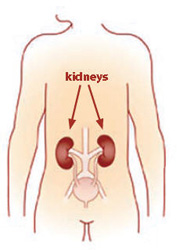March is National Kidney Month, a good time to check if you or your family are at risk for kidney disease or diabetes—conditions that affect millions of Americans.

Photo courtesy of NIH/NKDEP
Your kidneys play a very important part in keeping you healthy. These two bean-shaped, fist-sized organs are located in the middle of your back, on either side of the spine. Their main job is to filter your blood to remove wastes that could damage your body. They also help to control blood pressure and make hormones that your body needs to stay healthy.
Each kidney contains about one million tiny filters called nephrons. Inside each nephron are tiny blood vessels and urine collecting tubes. Most people develop kidney disease when the nephrons can no longer filter blood as well as they used to. Damage usually happens slowly, over many years. As more and more filters fail, the kidneys eventually are unable to keep the body healthy. At that point you need either dialysis or a kidney transplant.
You should be tested for kidney disease if you have any risk factors. (See "Kidney Disease: Early Detection and Treatment" on page 9.) Early kidney disease has no symptoms, which means you can't feel if you have it. Blood and urine tests are the only way to know if you have early kidney disease.
Proper treatment can help prevent further kidney damage and slow the progression of kidney disease. The earlier kidney disease is found, the sooner you can take medications and other steps that can keep your kidneys healthier longer.
If you are at risk for kidney disease,
there are steps to take to help protect your kidneys:
- Manage your diabetes
- Keep your blood pressure below 130/80 mmHg
- Take medicines as prescribed.
If your body is unable to use blood sugar called "glucose" the way it should, you have diabetes. A healthy body uses glucose for the energy it needs to do everything it does, including make new cells. If the cells of the body can't use glucose the way they should, the glucose level increases to an abnormal level, causing damage to the kidneys, eyes, feet, heart, and other parts of the body. Almost 21 million Americans have some form of diabetes—and 6.2 million of them are undiagnosed. That's why it's so crucial to detect and treat diabetes—or better yet, to prevent it.
Both kidney disease and diabetes are key areas of research for the National Institute of Diabetes and Digestive and Kidney Diseases (NIDDK) at NIH. The institute carries out research at the NIH campus in Bethesda, Maryland, and also funds the work of researchers around the world.
Type 1 Diabetes
Type 1 diabetes, formerly called juvenile diabetes or insulin dependent diabetes, is usually first diagnosed in children, teenagers, or young adults. Treatment for type 1 diabetes includes taking insulin shots or using an insulin pump, making healthy food choices, exercising regularly, controlling blood pressure and cholesterol. Islet cell transplantation is an experimental method sometimes used to help control blood glucose levels without insulin injections.
Type 2 Diabetes
Once considered "adult-onset diabetes" because only adults got it, type 2 diabetes is now a problem for some children as well. It is one of the fastest-growing conditions in Americans of all ages. Those people at most risk for getting type 2 diabetes include those who are 45 years of age or older, overweight or obese, don't get enough exercise, have close relatives who have type 2 diabetes, and who are American Indians, Alaska Natives, African Americans, Hispanic or Latino, or Pacific Islanders.
Treatment includes taking diabetes medicines, making healthy food choices, exercising regularly, taking aspirin daily, controlling blood pressure and cholesterol, and use of oral or injected insulin.
Gestational Diabetes
Some women develop gestational diabetes during the late stages of pregnancy. Although this form of diabetes usually goes away after the baby is born, a woman and her child who have had it are more likely to develop type 2 diabetes later in life. Gestational diabetes occurs most often in women who are obese or have a family history of diabetes. It is also more common among African American, Hispanic, American Indian, and Alaskan Native women.
